Can I train for a 5K in 10 weeks?
Training for a 5K race in a timeframe of 10 weeks is a realistic goal for many aspiring runners. This period allows enough time to gradually build up endurance, stamina, and running technique, minimizing the risk of injury. However, success depends on several factors including your base fitness level, commitment to training, and the right training plan. Whether you’re a complete beginner or someone with a bit of running experience, there’s a strategy to get you across the finish line.
For beginners, the key is to start slow, focusing on increasing the duration of your runs slowly over the weeks. A popular approach is the couch to 5K program, which alternates between walking and running until you build enough stamina to run continuously. On the other hand, experienced runners may focus on improving their time by incorporating speed work, tempo runs, and longer distance runs into their training regime. Consistency and patience are vital, as is listening to your body to prevent overtraining and injuries.
Incorporating rest days and cross-training activities such as cycling, swimming, or strength training can enhance your running performance and aid in recovery. Nutrition also plays a significant role in your training journey. Ensuring you fuel your body with the right nutrients and stay hydrated can make a substantial difference in your training output and overall health. Remember, each runner’s journey is unique, so adapting your training plan to your personal needs and progress is crucial for success.
How long does it take to get in shape for a 5K?
Preparing for a 5K race is a journey that varies greatly from one individual to another, depending on factors such as current fitness level, running experience, and personal goals. Generally, beginners might find themselves needing anywhere from 6 to 12 weeks of consistent training to feel ready to tackle a 5K race comfortably. This timeline allows for a gradual increase in mileage and intensity, helping to avoid injuries and build stamina effectively.
For those who are new to running, starting with a mix of walking and running is often recommended. Initially, you might run for 1-2 minutes and walk for 2-4 minutes, repeating this cycle for the duration of your workout. As your endurance improves, the walking intervals decrease, and the running intervals increase. An 8-week couch to 5K program is a popular choice for beginners, systematically preparing your body for the 3.1-mile distance.
Experienced runners or those with a higher baseline level of fitness may require a shorter preparation time. For them, 4 to 6 weeks of focused training can be sufficient to enhance their 5K performance. This phase should include various types of workouts, such as long runs, speed work, and strength training, aimed at improving pace, endurance, and overall physical condition.
Can you go from 5K to half marathon in 10 weeks?
Transitioning from a 5K to a half marathon in just 10 weeks is an ambitious goal, yet it’s one within the realm of possibility for many runners, provided they follow the right training protocol and maintain a healthy lifestyle. The jump from 3.1 miles to 13.1 miles requires not just an increase in physical endurance but also an adaptation in mental stamina. It’s vital for runners to approach this challenge with a carefully structured plan that gradually builds distance and intensity to avoid injury and burnout.
When considering whether you can make this leap, it’s essential to evaluate your current running foundation. Runners who have recently completed a 5K and are consistently running several times a week may have a sufficient base to begin a half marathon training plan. Key to success will be integrating varied workouts into your regimen, including long runs for endurance, speed work for improving pace, and strength training to prevent injury. Each aspect plays a pivotal role in preparing your body and mind for the demands of a half marathon.
Moreover, rest and recovery are equally critical components of a successful transition from 5K to half marathon. Allowing your body ample time to recover between runs with proper sleep, nutrition, and hydration will enhance your performance and reduce the risk of injuries. Incorporating low-impact cross-training activities can also be beneficial in improving cardiovascular fitness while giving your running muscles a much-needed break.
No se han encontrado productos.
How many days a week should you train for a 5K?
Deciding on the optimal number of training days for a 5K run can significantly influence your performance and enjoyment of the race. A common question amongst aspiring runners and fitness enthusiasts alike is «How many days a week should you train for a 5K?» The answer, while individual, generally falls into a recommended range based on fitness levels and running goals.
For beginners, starting with three to four days a week can provide a solid foundation without overwhelming the body. This schedule allows for a balanced approach, incorporating running, rest days for recovery, and cross-training to improve overall fitness and prevent injuries. It’s essential to listen to your body and adjust the training volume and intensity as needed.
Moderate to experienced runners might aim for four to five days a week, with a mix of short runs, longer distances, and interval training. This approach helps build endurance, speed, and running efficiency. Remember, quality over quantity matters more in training than simply stacking days. Ensuring each session has a purpose and progressively challenges you is key to advancing towards your 5K goal.




